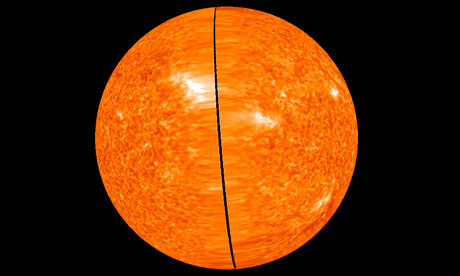The images from Nasa's $500m Stereo mission will be used to create a three-dimensional map of the sun in an attempt to understand its innermost workings.
The identical, refrigerator-sized probes, which were launched in 2006, follow the Earth's orbit around the sun, one leading far ahead of the other. Today, the probes became directly aligned on either side of the star, giving scientists a unique opportunity to see it from every angle.
Three-dimensional images showing the entire surface of the sun have been released for the first time.
This will enable significant advances in space weather forecasting for Earth and improve planning for future spacecraft missions throughout the solar system.
The images are believed to be as significant as those taken of the first men on the Moon.
Information about sunbursts was also collected by the satellites, which could be vital for protecting communications on Earth.
Astronomer Robin Scagell told Sky News that a big solar storm on the sun could have a devastating impact on our lives.
"It could wipe out the satellites and what is more, it is quite likely it would knock out the power grids.
"Big currents up in the sky caused by solar storms could cause them all to trip out and damage them.
"We do not have replacement units for these transformers.
Anything we can add to our human knowledge by having a much more detailed picture of our life giver will help scientists.Professor Heinz Wolff
"If the satellites give us warning when these storms are due to come we could perhaps shut down the power for 24 hours."
Scientist Professor Heinz Wolff told Sky News: "The sun is our life and small changes in the surface of the sun affect our life very considerably.
"By having a much better image of [the sun], it will make it easier to predict what it is going to do.
"For instance, climate scientists do not know whether climate changes are to do with the sun and anything we can add to our human knowledge by having a much more detailed picture of our life giver will help scientists."
The Solar Terrestrial Relations Observatory mission launched its two satellites in 2006.
They are travelling at different speeds and so every few years they achieve 180 degrees of separation on exactly opposite sides of the sun, enabling them to take the pictures.
